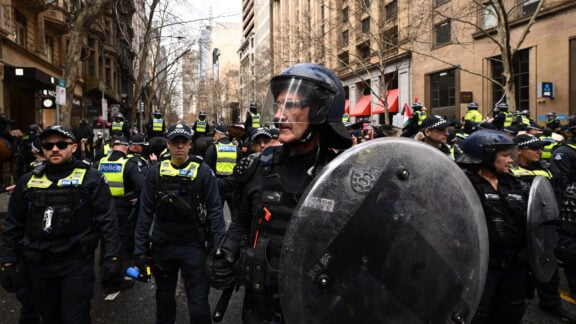The Premier of Victoria, Daniel Andrews, has given Victorians two weeks to adjust to wearing a fitted two-ply mask that covers nose and mouth when they go out in public. Covering your face in public with a plastic face shield or with a cloth such as a bandana or scarf will no longer be deemed enough protection against the COVID-19 in public spaces and you risk a fine if you do not comply.
Mr Andrews was quoted by Broadsheet as saying: “With more people moving across the city, our public health team have advised the rules around wearing a mask need to be strengthened. As I’ve said before, wearing a face covering is a small sacrifice – but it makes a huge difference in keeping all of us safe.”
According the new changes members of the public will be able to wear face shield but they must also wear at least a “two-ply mask” although Victoria’s Department of Health and Social Services (DHHS) recommends wearing a three-ply mask.
Martha Tsamis, owner of Inflation and Chasers’ night clubs -who through Oz Medical has turned her hand to providing masks, sanitiser packs and hand-sanitising stations since COVID-19 reared its head in March- said her masks were three-ply and already complied with DHHS requirements.
“Our masks (which come from Canada) are in line with COVID-safe policies,” she said. The masks can also carry a company logo and have been used by broadcast outlets, coffee shops, restaurants and hair dressing salons.
N95 surgical masks are probably the most effective, she said, but the cloth masks were more comfortable with adjustable straps.
“We have sold thousands nationwide,” she said. OzMedical is also selling work COVID accessories including a Temperature Scanning Machine for shops.
READ MORE: Greek-Australian mask producers rush to meet demand before tonight’s rules
Associate Professor Vicki Kotsirilos AM (of La Trobe and Western Sydney Universities) told Neos Kosmos that: “Surgical masks are usually favourable. Cloth masks are generally better for the environment and re-usable but they must abide with Government guidelines to be three layers and the cotton layer on the inside of the mask, cotton/polyester blend in the middle, and polyester/polypropylene on the outside. The reason for this, is that cotton absorbs moisture but polyester/polypropylene is more water resistant and can help prevent absorption of other people’s droplets.
She added that hand hygiene and the 1.5 metre distance between people when outdoors are still applied.
Prof Kotsirilos noted that there were some concerns being raised regarding the wearing of masks in public spaces in Victoria.
READ MORE: Mask and hand hygiene protect against COVID-19: Prof Kotsirilos
“There are clearly situations to wearing masks that the community have raised with concerns. For example, there are overpopulated areas of metropolitan Melbourne where regular joggers and walkers are sharing pedestrians tracks and at many times pass each other within the 1.5m’ safe distance,” she said.
“Sportspeople such as joggers breathe heavily and spread respiratory droplets more widely. Whilst COVID transmission is less outdoors compared with indoors, why are stricter guidelines for masks in place for walkers but not joggers in concentrated areas? Cyclists are also exempt but tend to be more than 1.5m apart.
“People living in open spaces and rural areas where there are no people around, also need to wear masks when outside their property yet there may be no people in sight. These are example of situations that the Department of Health should consider and possibly revise guidelines,” said Professor Kotsirilos.
She said that depending on the environment/setting, the COVID virus could travel up to six metres as a spray according to some studies depending on the environment and this was the reason why masks and physical distance of greater than 1.5m were needed when outdoors.
♦ For more information on wearing and preparing face masks follow the dhhs link.
READ MORE: Facial masks – the dos and don’ts in the fight against COVID-19







